#Recycling clothes DIY!
Explore tagged Tumblr posts
Text
Fabric bracelets part 2: embroidery






These took so long but it was so worth it, I'm very proud of these
[Image ID: six images of three different fabric cuff bracelets. One is a blue/purple cuff with green wavy leafy vine embroidery that curls towards both ends of the bracelet. The design is on both sides of the spikes down the length of the bracelet, same placement as the others. All three bracelets have small metal spikes down the middle. The second bracelet is a desaturated red color, with a gray barbed wire design along both sides of the spikes. The third bracelet is a red and black flannel pattern, with a lighter silvery gray barbed wire embroidery in a slightly different style. The first barbed wire design is a little more stylized while the one on the black and red cuff is a little more realistic looking in its shape, but both are simplistic designs. All bracelets have button closures and three buttons to allow the wearer to adjust the size. All bracelets are roughly 9-10.5 inches long when open and flat and 2.5 inches wide. End ID]
#punk#punk diy#punk fashion#punk clothes#punk jewelry#jewelry#fashion#diy#upcycled fashion#upcycled jewelry#upcycling#upcycle#solarpunk#solarpunk diy#solarpunk fashion#solarpunk aesthetic#hopepunk#ecopunk#sustainable fashion#sustainability#recycling#hatchet makes stuff#embroidery#sewing#jewelry making#bracelets#hand sewing#hand embroidery
919 notes
·
View notes
Text


made this spiderweb tank quite a while ago when i was in highschool and it’s horrible, so i reworked it into this cute skull top 🖤
24 notes
·
View notes
Text


I upcycled a dress shirt I got into something much more interesting
#mothman#cryptids#cryptid#upcycle#upcylced#diy projects#clothing#grunge#grungy aesthetic#grunge clothes#recycling#spooky art
22 notes
·
View notes
Text

Recylced some old garbage shirts to make a new one. It reads “46 skateboarding rats, man!”
7 notes
·
View notes
Text
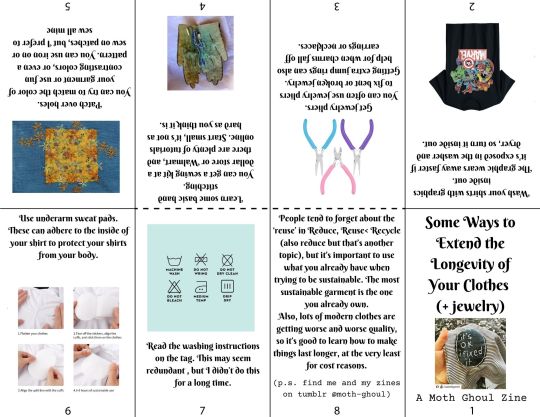
little things that i try to do to get more out of my clothes
#moth types#moth's zines#moth ghoul#zines#diy#punk#diy zine#punk zine#sewing#mending#clothing#sustainability#reduce reuse recycle#diy clothing
74 notes
·
View notes
Text

made myself a new belt :)
printed cotton, embroidery thread, and a metal belt buckle
2 notes
·
View notes
Text
May I present the most recent addition to my DIY clothing collection, my Bikini Kill shirt!
Just used acrylic and heat treated it because I’m frankly too lazy to screen print.

#diy#diy clothes#punk clothes#bikini kill#punk#riot girl#riot grrl#doing my best#reduce reuse recycle#fuck corporate greed
6 notes
·
View notes
Text
Cropped Jean Jacket from Old Denim Sewing
In this post, you will learn how to sew cropped jean jacket with super easy self drafting tutorial. Are you looking to add a unique touch to your wardrobe without breaking the bank? Dive into the world of sustainable fashion with my easy-to-follow sewing tutorial that transforms your old jeans into a stylish cropped jean jacket. Perfect for beginners, this guide will walk you through simple…
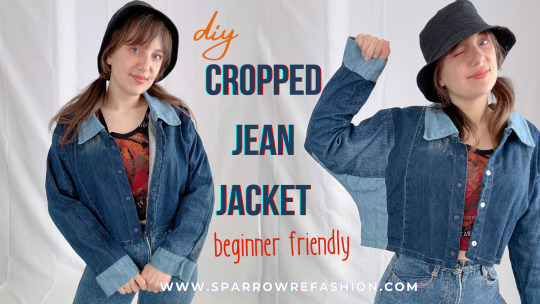
View On WordPress
#Beginner Sewing Projects#Cropped Jean Jacket#denim crafts#DIY Denim Upcycle#eco-friendly clothing#fashion DIY#pattern drafting#Recycled Fashion#sewing tutorial#sustainable fashion
5 notes
·
View notes
Text
Next project for the Etsy shop: cloth pads aka Cooter Cozies!

2 notes
·
View notes
Text
also love that luc receives one (1) whole rose from alistair and immediately incorporates it into his aesthetic motifs for the rest of his life. he has zevran give him a tattoo of it he has like 5 different dangly earrings with roses he starts incorporating floral swatches into his robes its SO normie of him
#luc posting#btw i think the circle apprentices diy clothes modification game is out of this fucking world#you're a bored 14 year old and you want to ~*~express yourself~*~ but you're stuck wearing these bland uniform robes#we're talking patches we're talking safety pins we're talking recycling and reusing fabric#working with whatever scraps and bits and baubles you can get your hands on rips tears distressing#templars crack down on dress code from time to time but for the most part irving is quite permissive#magic stones fade-touched swatches metal from old staves completely aesthetic rings and buckles#luc starts a fingerless glove trend among the apprentices#which lasts until he gets his hands on a pair that leave just the middle finger exposed#'what no gregoir im definitely NOT flipping you off its an ORLESIAN design i read about it in the library'
3 notes
·
View notes
Text
OP notes that despite the many jeans pics in the post, these mends will work on pretty much any fabric.
Visible Mending
Introduction:
Visible mending is a decorative way to fix up an item. Instead of trying to make your mend as invisible as possible, the idea is to make it part of the garment's design.
Visual mending is not a single technique: it's more of a mindset. If you've got an item you love, it deserves to be mended, and if you're going to put that love into stitches, why not show them off?
That being said, there are some specific techniques that are popular with visible menders. Let's take a look!
Sashiko:
Sashiko is a type of traditional Japanese embroidery that is used to both decorate and reinforce fabric. In visible mending, sashiko is often used to cover up holes with patches or to reinforce thinning fabric. This technique uses a variation on the running stitch.
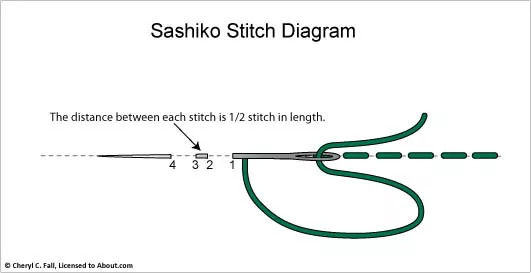
(Image source) [ID: sashiko stitch diagram: the distance between each stitch is 1/2 stitch in length.]
Some resources on sashiko:
SashiCo on YouTube: sashiko livestreams and information on the cultural aspect of sashiko.
Written tutorial by Upcycle Stitches.
Free sashiko templates by TheSpruceCrafts.
Fixing jeans with sashiko by Soluna Collective.
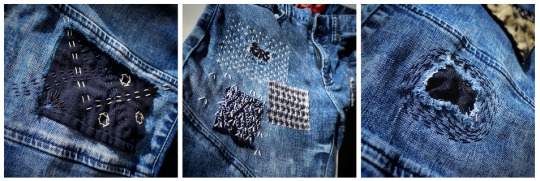
(Image source) [ID: three examples of sashiko embroidery on jeans fabric.]
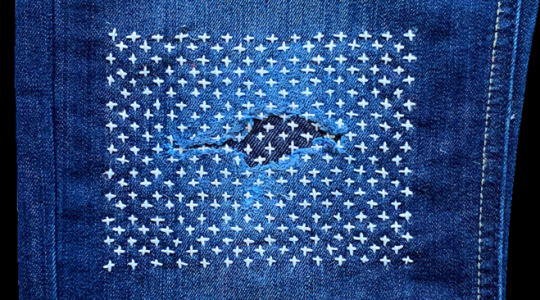
(Image source) [ID: sashiko embroidery with white thread on blue jeans fabric.]
Embroidery:
Regular embroidery is also a popular technique to accentuate your mends. Check out my embroidery 101 post to learn how to get started. You can embroider patches, or use embroidery to hide or accentuate any stitches you've made to fix holes. Embroidery's also a great way to cover up stains.
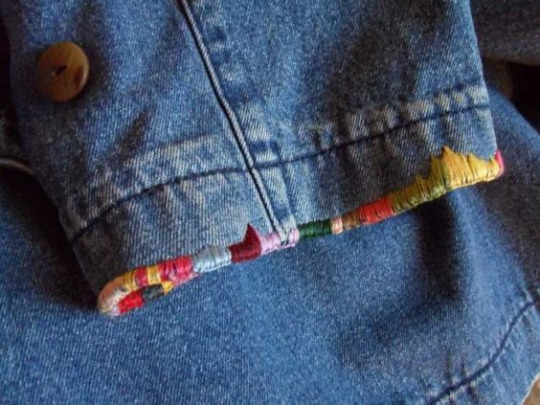
(Image source) [ID: colourful embroidery floss covers a worn sleeve edge of a jeans jacket]
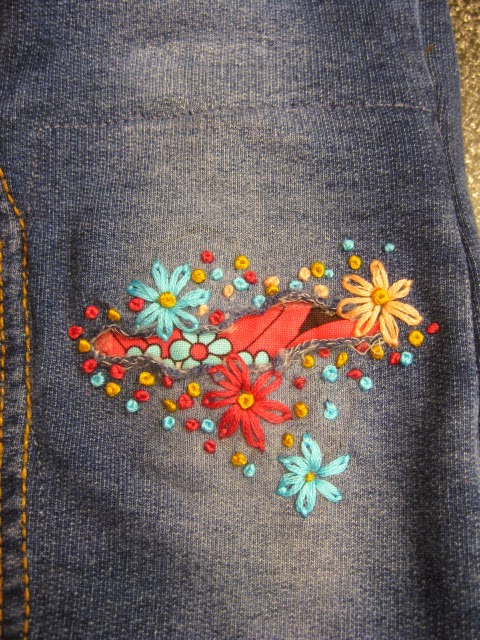
(Image source) [ID: colourful flower embroidery surrounds a hole in a pair of dark gray jeans. Fabric with a red and black flower print peaks out of the hole.]
Patches:
There are many ways to add patches to a garment. My tutorial on patches is a good place to start if you want to make custom-shaped patches to sew on top of your fabric. You can also sew your patch on the inside of your garment and have it peek out from beneath the hole you're trying to fix. Fun ideas for this are lace or superheroes.
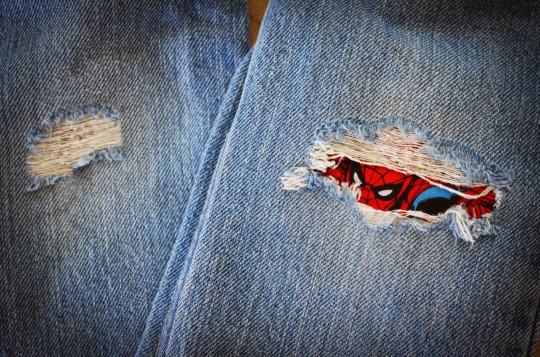
(Image source) [ID: Spiderman peaking out of a rip in a pair of blue jeans.]

(Source) [ID: a red flannel heart-shaped elbow patch on a gray knitted sweater.]
Darning:
Darning is a technique used to repair holes in fabric by using running stitches to weave extra fabric over the hole as to fill it up again. While traditionally darning is done in an invisible way by using the same colour of thread as your fabric, you can also use contrasting colours to accentuate your fix. Check out this written tutorial on darning by TheSpruceCrafts.

(Image source) [ID: vintage instructions on how to darn a hole.]
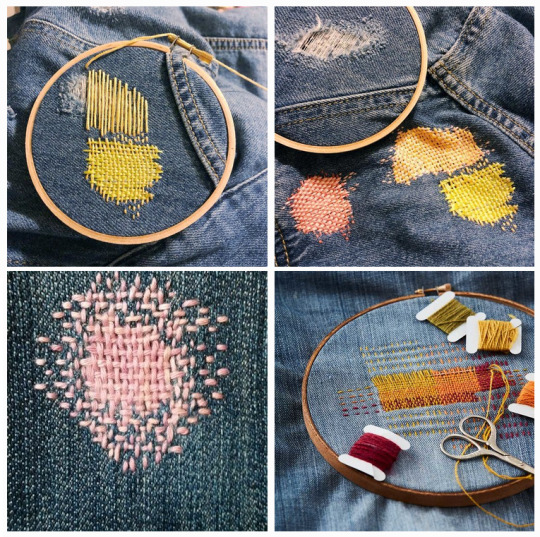
(Image source) [ID: four examples of darning on blue fabric with colourful contrasting thread.]
Conclusion:
Visible mending is a creative way to fix up your clothes and give them some personality at the same time.
You should be proud of the fact that you took the time and learned the necessary skills needed to mend your clothes! Show off what you did!
A fun side effect of wearing these obvious mends is that people will notice them. They'll remember your fixes the next time they're faced with a hole in their wardrobe, and it will make them more likely to try it for themselves.
These are just a few ways to visibly mend your garments. Want more inspiration? Check out Pinterest or r/Visiblemending on Reddit.
#wasteless crafts#visible mending#mending#fibre crafts#fibre art#embroidery#sashiko#darning#patches#sewing 101#sewing for beginners#tutorial#diy#upcycling#reuse reduce recycle#recycling clothes#fast fashion#slow fashion#fabric#global warming#climate change#sewing#sewing by hand#sustainable fashion#sustainability#zero waste#zero waste crafts#jeans#solarpunk
98K notes
·
View notes
Text
DIY Knit Cap with VISOR - from your closet


#DIY Knit Cap with VISOR - from your closet#upcycled#recycled style#recycling clothes#one of a kinds#diy
1 note
·
View note
Text
Homemaking, gardening, and self-sufficiency resources that won't radicalize you into a hate group

It seems like self-sufficiency and homemaking skills are blowing up right now. With the COVID-19 pandemic and the current economic crisis, a lot of folks, especially young people, are looking to develop skills that will help them be a little bit less dependent on our consumerist economy. And I think that's generally a good thing. I think more of us should know how to cook a meal from scratch, grow our own vegetables, and mend our own clothes. Those are good skills to have.
Unfortunately, these "self-sufficiency" skills are often used as a recruiting tactic by white supremacists, TERFs, and other hate groups. They become a way to reconnect to or relive the "good old days," a romanticized (false) past before modern society and civil rights. And for a lot of people, these skills are inseparably connected to their politics and may even be used as a tool to indoctrinate new people.
In the spirit of building safe communities, here's a complete list of the safe resources I've found for learning homemaking, gardening, and related skills. Safe for me means queer- and trans-friendly, inclusive of different races and cultures, does not contain Christian preaching, and does not contain white supremacist or TERF dog whistles.
Homemaking/Housekeeping/Caring for your home:
Making It by Kelly Coyne and Erik Knutzen [book] (The big crunchy household DIY book; includes every level of self-sufficiency from making your own toothpaste and laundry soap to setting up raised beds to butchering a chicken. Authors are explicitly left-leaning.)
Safe and Sound: A Renter-Friendly Guide to Home Repair by Mercury Stardust [book] (A guide to simple home repair tasks, written with rentals in mind; very compassionate and accessible language.)
How To Keep House While Drowning by KC Davis [book] (The book about cleaning and housework for people who get overwhelmed by cleaning and housework, based on the premise that messiness is not a moral failing; disability and neurodivergence friendly; genuinely changed how I approach cleaning tasks.)
Gardening
Rebel Gardening by Alessandro Vitale [book] (Really great introduction to urban gardening; explicitly discusses renter-friendly garden designs in small spaces; lots of DIY solutions using recycled materials; note that the author lives in England, so check if plants are invasive in your area before putting them in the ground.)
Country/Rural Living:
Woodsqueer by Gretchen Legler [book] (Memoir of a lesbian who lives and works on a rural farm in Maine with her wife; does a good job of showing what it's like to be queer in a rural space; CW for mentions of domestic violence, infidelity/cheating, and internalized homophobia)
"Debunking the Off-Grid Fantasy" by Maggie Mae Fish [video essay] (Deconstructs the off-grid lifestyle and the myth of self-reliance)
Sewing/Mending:
Annika Victoria [YouTube channel] (No longer active, but their videos are still a great resource for anyone learning to sew; check out the beginner project playlist to start. This is where I learned a lot of what I know about sewing.)
Make, Sew, and Mend by Bernadette Banner [book] (A very thorough written introduction to hand-sewing, written by a clothing historian; lots of fun garment history facts; explicitly inclusive of BIPOC, queer, and trans sewists.)
Sustainability/Land Stewardship
Braiding Sweetgrass by Robin Wall Kimmerer [book] (Most of you have probably already read this one or had it recommended to you, but it really is that good; excellent example of how traditional animist beliefs -- in this case, indigenous American beliefs -- can exist in healthy symbiosis with science; more philosophy than how-to, but a great foundational resource.)
Wild Witchcraft by Rebecca Beyer [book] (This one is for my fellow witches; one of my favorite witchcraft books, and an excellent example of a place-based practice deeply rooted in the land.)
Avoiding the "Crunchy to Alt Right Pipeline"
Note: the "crunchy to alt-right pipeline" is a term used to describe how white supremacists and other far right groups use "crunchy" spaces (i.e., spaces dedicated to farming, homemaking, alternative medicine, simple living/slow living, etc.) to recruit and indoctrinate people into their movements. Knowing how this recruitment works can help you recognize it when you do encounter it and avoid being influenced by it.
"The Crunchy-to-Alt-Right Pipeline" by Kathleen Belew [magazine article] (Good, short introduction to this issue and its history.)
Sisters in Hate by Seyward Darby (I feel like I need to give a content warning: this book contains explicit descriptions of racism, white supremacy, and Neo Nazis, and it's a very difficult read, but it really is a great, in-depth breakdown of the role women play in the alt-right; also explicitly addresses the crunchy to alt-right pipeline.)
These are just the resources I've personally found helpful, so if anyone else has any they want to add, please, please do!
#homemaking#homemaking resources#gardening#urban gardening#self sufficiency#self sufficient living#sustainability#sustainable living#homesteading#nontrad homemaker#nontrad housewife#urban homesteading#solarpunk#cottagecore#kitchen witch#kitchen witchcraft#crunchy to alt right pipeline#book rec#book recommendations#resource#long post#mine#racism tw#racism mention#transphobia tw#transphobia mention
32K notes
·
View notes
Text
#artists on tumblr#embroidery#knitting#my sewing#needlework#painting#quilting#sales#sewing#startup#best handmade items#best kantha quilt#patola qulit#recycling fashion#upcycling clothes#upcycling art#upcycling ideas#slow fashion#visible mending#upcycle#diy craft#sustainable
1 note
·
View note
Text
youtube
#upcycle#upcycling#diy#diy clothes#diy socks#this is freakin awesome!#i have so much misc fabric i just dont wanna discard#bc itd be wasteful and also cuz it cant be recycled (plastic fibers etc)#but i rlly want to get good at sewing#i have such anxiety abt all the steps of it but i rlly just need to do it!#sewing#Youtube
0 notes
Photo
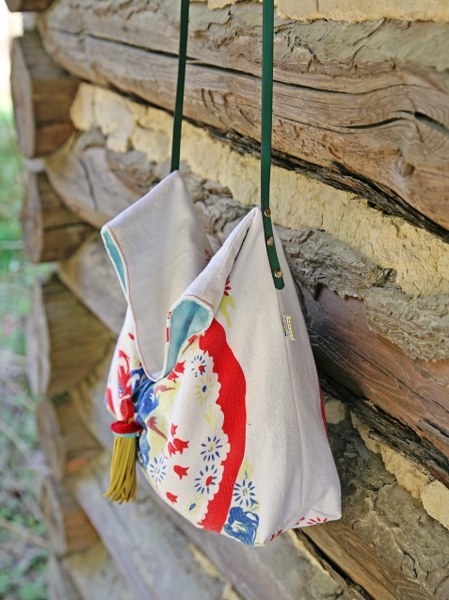
Cute cross-body bag made from an old tablecloth. Definitely saving this tip! Tutorial by Ashlee at My So Called Crafty Life.
#sewing#DIY#handmade#recycling#upcycling#repurposing#thrifted#tablecloths#table cloths#bags#purses#cross-body#tassels
1 note
·
View note